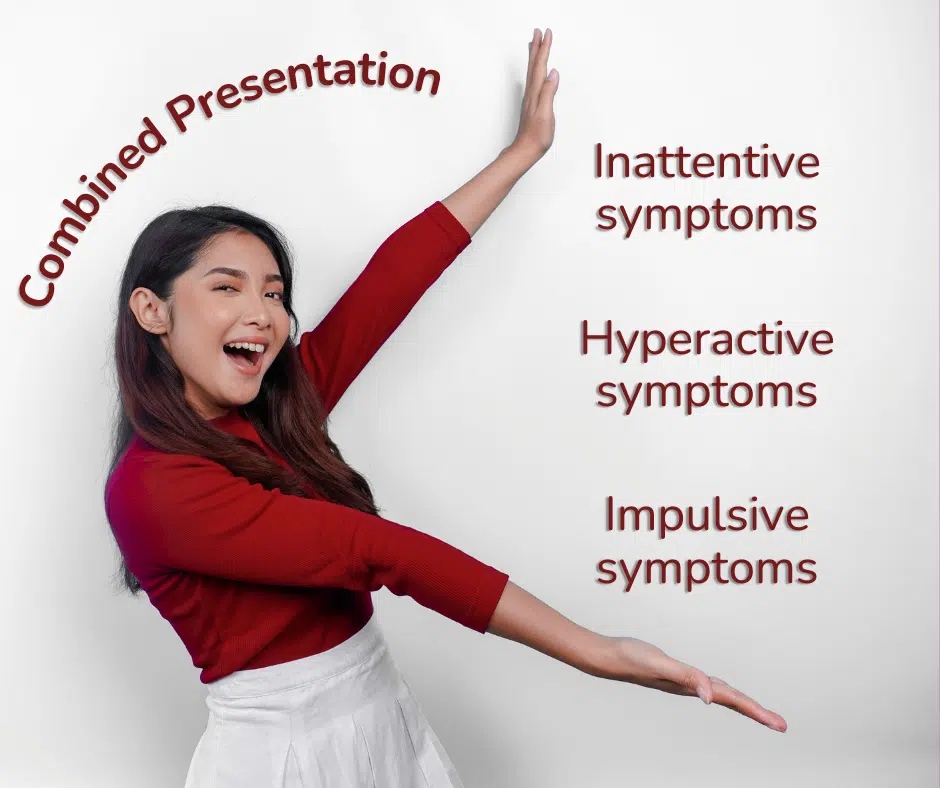ADHD, or Attention-Deficit/Hyperactivity Disorder, is a common neurodevelopmental disorder that affects millions of people worldwide. However, diagnosing ADHD or ADD can be tricky, as it requires careful consideration of different factors. In this comprehensive guide, I'll share the essential aspects of diagnosing ADHD, including symptoms, types of ADHD tests, and the role of mental health professionals like myself.
Whether you're seeking clarity for yourself, your partner, or your child, you've already taken the first step in your ADHD diagnosis journey! Understanding how we diagnose ADHD is crucial for accessing appropriate support and treatment. Let's explore the key steps and considerations involved in testing for ADHD and what's involved in making an ADHD diagnosis.
ADHD Types and Symptoms
ADHD has three primary subtypes or presentations: predominantly inattentive, predominantly hyperactive-impulsive, and combined type.
Inattentive ADHD

The predominantly inattentive presentation of ADHD is is the same thing as "ADD" or Attention-Deficit Disorder. Common inattentive ADHD symptoms include...
- Struggling to stay focused (easily distracted)
- Poor organizational skills, and a messy room, desk, or living space
- Mind-wandering
- Not paying attention to smaller details, often missing things or making "careless mistakes"
- Frequently losing or misplacing things
- Forgetfulness in daily activities and responsibilities
- Avoiding boring tasks or tasks that require sustained mental effort or energy
- Difficulty starting or finishing tasks
- Poor time management skills
- Not being able to remember what was just read and having to re-read it (aka poor working memory)
Hyperactive-Impulsive ADHD

People with the predominantly hyperactive-impulsive presentation of ADHD typically display hyperactivity and impulsivity. This is the subtype that often comes to mind when people hear "ADHD," however it's less common than the inattentive subtype. Hyperactive and impulsive ADHD symptoms include...
- Constant fidgeting or squirming
- Hyperactivity or high energy
- Interrupting others when they're talking or busy
- Getting noticeably impatient or frustrated when waiting in line
- Struggling with impulse control
- Having difficulty relaxing (aka restlessness)
- Engaging in risky behaviors without considering consequences
- Excessive talking in social situations, often dominating conversations or oversharing
- Appearing to be driven by a motor, or feeling compelled to do things
Combined Type ADHD

The combined presentation of ADHD is just as it sounds: it involves a combination of inattentive, hyperactive, and impulsive symptoms. People with this subtype exhibit a broad range of ADHD symptoms across both domains.
It's important to recognize that ADHD symptoms can vary widely among individual people. Also, ADHD symptoms and their severity in one person can change over time.
Diagnosing ADHD
Diagnosing ADHD involves a comprehensive assessment process that considers a few factors, including medical history, behavioral observations, and standardized criteria outlined in the Diagnostic and Statistical Manual of Mental Disorders (DSM-5).
DSM-5 ADHD Diagnostic criteria

The DSM-5 provides specific criteria for diagnosing ADHD in adults and older children, which include:
- Persistent patterns of inattention and/or hyperactivity or impulsivity that significantly interfere with functioning or development.
- Symptoms must be present before the age of 12.
- Symptoms must be present in two or more settings (e.g., home, school, work).
- Clear evidence that symptoms interfere with or reduce the quality of social, academic, or occupational functioning.
- Symptoms cannot be better explained by another mental health condition (such as autism or borderline personality disorder.)
What experts are looking for when diagnosing ADHD
To meet the diagnostic criteria for an ADD or ADHD diagnosis, you must have enough symptoms from the inattentive and/or hyperactive-impulsive categories, as specified by the DSM-5. Healthcare professionals - such as the ADHD expert therapists and psychologists at the Sachs Center - conduct thorough evaluations. During ADHD evaluations, our doctors observe ADD or ADHD symptom severity, duration of symptoms, and assess how much ADHD impacts your daily functioning.
ADHD Testing Methods
Diagnosing ADHD accurately in adults, teens, and children requires a comprehensive approach. Psychologists may use different ADHD testing methods tailored to your age, circumstances, and presenting symptoms. A full assessment for teens and adults might include a combination of clinical interviews, behavior rating scales, neuropsychological testing, and medical evaluations. For younger children, the psychologist may collaborate with parents and teachers to gain a fuller understanding of the child's symptoms in different settings.
At the Sachs Center in New York City, our experts do both an 8 hour comprehensive neuropsychological evaluation as well as a simple 2-hour diagnostic ADHD evaluation.
You may asking what is the difference and which one do I need?
Comprehensive Neuropsychological Evaluation
One type of ADHD testing involves what's known as a comprehensive neuropsychological evaluation. A neurospychological evaluation looks at different aspects of a patient's mental health, as well as testing their IQ, cognitive functioning, academic abilities, emotional functioning and executive functioning. It's quite thorough and takes anywhere from 6 to 12 hours to complete with a qualified expert. After the testing is done, the psychologist spends a few weeks writing up the 25 page report with the feedback and results. Because it requires a lot of time and effort, it can be quite expensive, often costing more than $5,000.
Is Comprehensive Neuropsychological Testing the right option for me?
People usually seek out this type of evaluation for very specific reasons, like getting extra time on tests such as the MCAT, LSAT or GRE. Sometimes, organizations or entities - like the United States Military - might require this evaluation for certain purposes. Colleges require this type of testing to receive accommodations at the school. However, for most people who are just trying to figure out if they have ADD or ADHD, this evaluation is really not necessary.
2-Hour Diagnostic ADHD Testing
At the Sachs Center, our 2 hour diagnostic process uses the same scientifically valid ADHD testing questionnaires from the comprehensive neuropsychological evaluation. We do not, however, test your IQ, cognitive or academic abilities. The 2 hour ADHD testing process is really just for your benefit to know if you or your loved one has ADHD. At the conclusion of the testing, you will receive a letter indicating if you have ADHD. This letter can be used to seek accommodations at your company.
Our 2 hour diagnostic testing is done virtually on Zoom or Google Meet.
Interested in ADHD testing at the Sachs Center?
The process of diagnosing ADHD begins with a formal diagnostic interview. We ask about your background, family history, and current concerns related to ADHD symptoms. This initial step helps us gain a thorough understanding of your situation. Next, you'll undergo a battery of structured questionnaires designed to give more insight into your ADHD symptoms.
While not necesssary, it is helpful to have close family members or partners fill out a questionnaire about you as well. Understanding the real-world impact of your symptoms—whether it's managing finances, maintaining relationships, or staying focused on tasks—is crucial for an accurate diagnosis and personalized treatment plan. Involving your close circle offers valuable perspectives that enhance our assessment of your symptoms and improve diagnostic accuracy.
Conclusion
Diagnosing ADHD is a complex process that involves understanding symptoms, evaluating their impact, and considering different testing methods. With proper diagnosis and treatment, children and adults with ADHD can learn to manage their symptoms and lead fulfilling lives.
Your ADHD diagnosis journey begins with your first appointment at the Sachs Center.